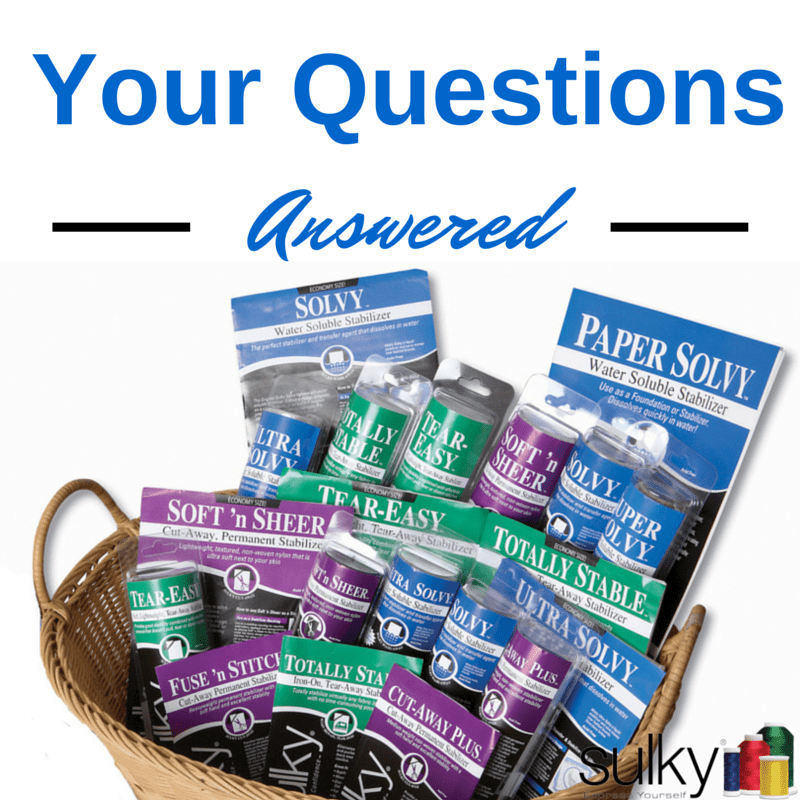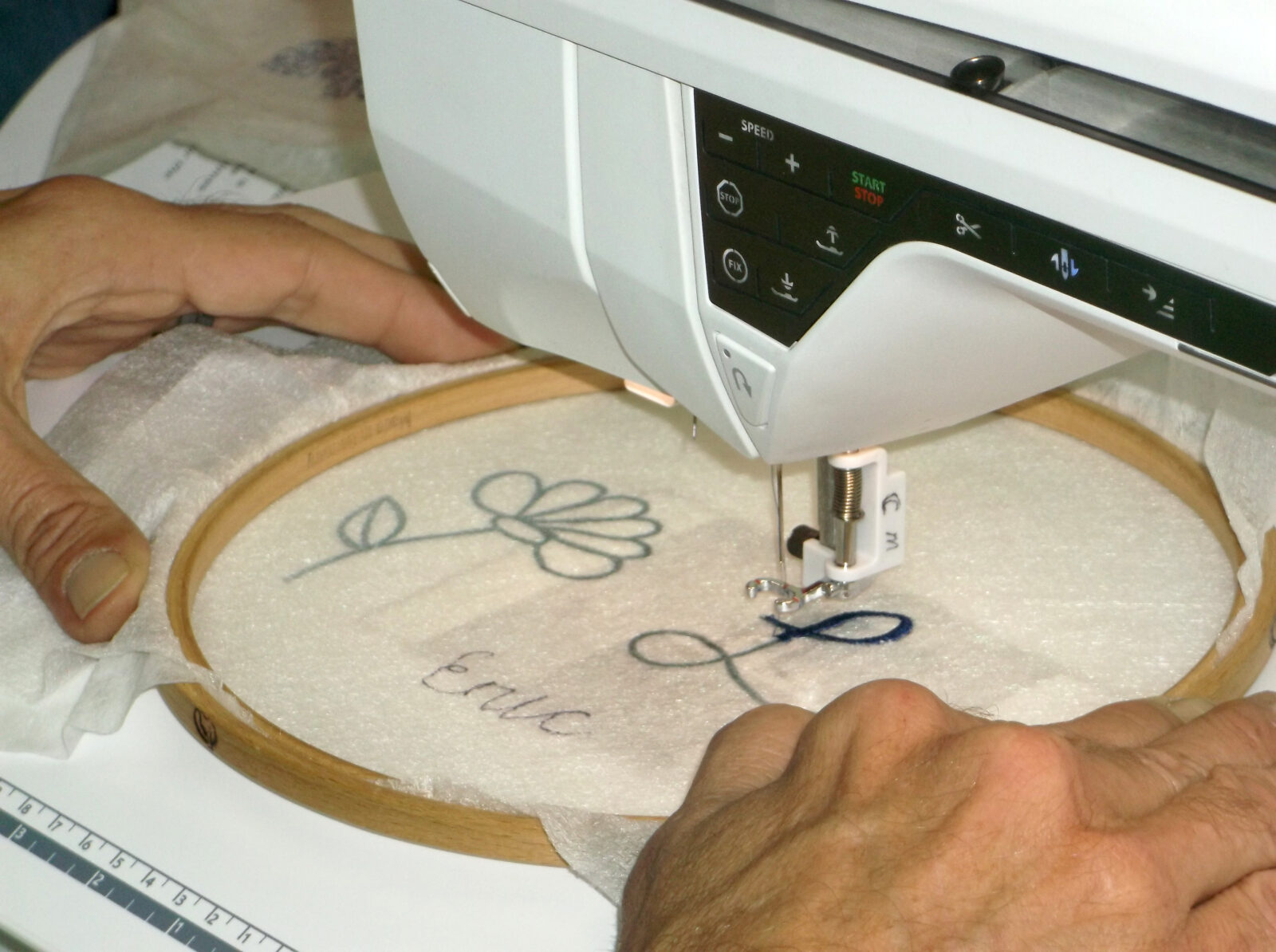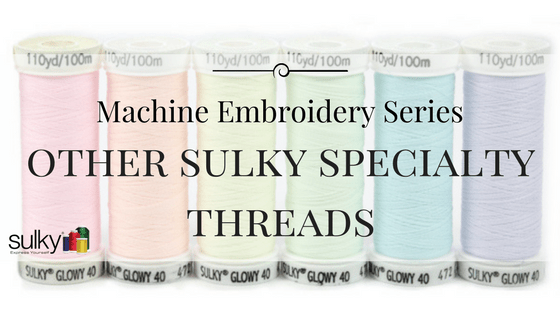
The Stabilizer Series – Your Questions Answered

I am so excited about the response we have gotten to this series! I was going to wait and do Q and A at the end of it, but we have had so many questions already, I thought I would do a couple posts in the middle of this series with answers to your specific questions. (If you want to catch up, you can read the first post here and the second post in the series here)
So here are your questions and answers:
Tell me what stabilizers to use for Terry Bath Towels, please. This is a huge challenge to me!
Most often for bath towels, I use 1 – 2 layers of Sulky Tear-Easy™, depending on the thickness of the towel and I always use Solvy® as a topper. The Solvy keeps all the loops and such under control so they don’t peek through the stitching. Another option would be to use Sulky Heat-Away™ Stabilizer as a topper, and just pull it away from the design when finished, and then it remains under the stitching after washing and can help prevent “pokies” down the line. This only works if there are no open areas in the design.
Bonus Tip: If you don’t want to hoop your towel, hoop a piece of Sticky +, then iron a piece of Totally Stable on the back of the towel. The Totally Stable will stick to the Sticky + while protecting the loops of your towel from the Sticky +! You will still need a topper which you can put on with KK 2000.
What is the best to put on the backs of a t-shirt for a t-shirt quilt I have to make?
The best backing for t-shirt for a t-shirt quilt is Tender Touch. It fuses to the shirt and stabilizes it without changes the hand of the t-shirt. If you want a little more stability and want to eliminate the stretch, you can use Soft ’n Sheer Extra™, which is also fusible.
Can you make a chart on stabilizers which is best fabric and knits? I am embroider . Please put it on the sulky sites.
With the number of stabilizers available and the endless amounts of variables that go into picking the right combo of stabilizers, needles, thread, etc., there aren’t any hard and fast rules. That being said, in general you will use a Tear Away stabilizer with a woven fabric and a Permanent stabilizer with a knit fabric. We do have a chart to help point you in the right direction. You can download it here: Stabilizing At A Glance
I want to put a name on the back of a 24-month’s t-shirt. I could not get it in my hoop without the front of the shirt getting in the way. So I opened the side seams up to get it to fit. Now, I can’t seem to get any stabilizer under the fabric. Is there a stabilizer I can put on top?
Sulky Solvy, Super Solvy and Heat-Away are all primarily “toppers” which means they go on the top of the design. You may also want to try “floating a piece of Tear-Easy under the hoop when you are embroidering this shirt to give you some extra stability. The other option would be to hoop the stabilizer instead of the t-shirt and use KK 2000 or a Sticky back stabilizer so you can stick the shirt to instead of hooping it.
What is the best stabilizer to use on burlap. I want to do some embroidery on a loose woven burlap and do not know what would be the best stabilizer. Thank you for any help you can give me and taking the time to answer this question.
Heat-Away should work for burlap! Burlap can take a lot of heat but not water so 1 – 2 layers of Heat-Away as a backing and then another layer as a topper, depending on how tightly the burlap is woven.
Why doesn’t Joann Fabric and Craft Stores carry your whole line of tube encased stabilizers anymore? Very frustrating trying to find them.
We think they should carry all of our stabilizers too :). If you would like to see more of our stabilizers in their stores. Please let them know via the “Contact Us” section on their website. If you can’t find them locally, you can find any Sulky products at these online retailers.
When I make thread lace with water soluble stabilizer, I frequently get goop on the needle, which I have to stop and clean off. It is not a really big deal, but if there’s a way I can avoid it, it would be better to do so. Is there a recommended needle type for this kind of sewing? When I do scarves, I typically use one layer of Sticky Fabri-Solvy and one layer of the lighter-weight Solvy. I adore making bowls, scarves, and thread lace to incorporate into my fiber art. It is highly addictive!! and such fun!! Your products are great!
Yes, thread lace is a wonderfully addictive hobby! When I am using any stabilizers that have a sticky back, I put a drop of Sewer’s Aid on my needle. This is true with fusible webs, too. This helps the needle glide through without picking up as much residue (which often comes from the sizing in the fabric, too). As far as needle choice goes, that depends more on the thread than the stabilizer. We have needle recommendations for all of our threads on Sulky.com and here is another chart you can download that may help you as well: Thread and Needle Guide
I am doing a dense embroidery design on a preshrunk 100% cotton shirt yoke. Is there a fusible stabilizer that will also act as an interfacing? I reduced my tension for the design, but it still puckers after the stabilizer is removed.
I would use Soft ‘n Sheer with KK 2000™ Temporary Spray Adhesive, or Soft ‘n Sheer Extra. Be careful with the Soft ‘n Sheer Extra to not use too hot of an iron. It is nylon and it can shrivel with too much heat. Steam is good; or a damp press cloth to protect the stabilizer from the hot iron. Test your iron with the Soft ‘n Sheer Extra. Also, when the embroidery is complete, press the Soft ‘n Sheer Extra lightly and peel up any extra and trim it with pinking shears along the design for minimal show-through. You can also use a layer of Heat Away as a topper. However, a design that is too dense for a knit, will never look relaxed and natural on a knit.
I have purchased several kinds of stabilizers from various companies seeing which ones I could work with the best when I was just starting out in sewing and wanted to do a lot of embroidery. Since then, I don’t know one from the other as the company’s I purchased them from did not come in containers or mark them. Is there a way to tell difference between the stabilizers?
If you no longer have the original packaging for your stabilizer, the best thing to do is purchase a Sampler Pack of our stabilizers. This pack gives you one 8” x 10” piece of each of the Sulky stabilizers and each one is labeled. You can use that to compare to the stabilizers you own, then go to our website to download all the information for that stabilizer.
Several years ago, Sulky put out a Heat-Away stabilizer which was a wonderful option for anyone who was embroidering on a napped fabric like towels. It was put on top of the fabric and embroidered over, then ironed around the design which removed the fibers beyond the edge of the design and the stabilizer stayed under the stitching to help prevent the nap from poking through and remained intact if you did not put an iron to it. Do you still sell Heat-Away?
What you seem to be describing is the old muslin-type Heat-Away, which was discontinued many years ago. But it was replaced with the film-type new Heat-Away. And Yes! I love the new Heat Away even more! It is perfect for exactly what you describe here and I also use it to “cheat” at free-motion quilting. If there is a design that I want on a quilt, I draw in onto the Heat Away, use KK 2000 to put the Heat-Away on the top of my project and I just follow the lines to sew. When I am finished, the hot iron takes away the Heat-Away and the KK 2000! If you are having trouble finding Heat-Away in your local store, go here to find where you can buy all of our products on-line.
I am really having a tough time with figuring out how to stabilize towels for embroidery.
I know I already answered a towel question, but that was specifically Terry Cloth towels. For most towels, the answer is the same, Tear-Easy (1 or 2 layers) on the bottom and Solvy on the top. However, for a more decorative kitchen or bath towel, you may decide that you want a permanent stabilizer to help avoid the design “balling up” when you wash it. In this case, Soft ‘n Sheer may be a better choice. Once you have finished the embroidery, simply trim the Soft ‘n Sheer as close to the design as possible. If you use Soft ‘n Sheer Extra, trim it with pinking shears and then iron in down with a warm (not hot) iron.





9 Comments
Kris
Fabulous blog! Have learned so much.
Debbie
What kind of stabilizer would you use on nylon running shorts?
Kelly Nagel
Debbie, I would use Sulky Tear-Easy. Depending on how dense the design that you are stitching on, you may need more than one layer. Since Nylon is so slippery, you may want to spray some KK 2000 on the Tear-Easy to help hold those shorts in place. Let me know how they come out!
Charlotte Matthews
Does stick-on stabilizer last through washings, dryings, dry-cleaning?
Kelly Nagel
Sticky Fabri-Solvy is a water soluble stabilizer so it will go completely away with water. Sticky + is a tear away stabilizer and any stabilizer that is left after tearing away the access should remain through normal wear and tear.
Prema
Totally stable stabilizer – where why and how to to use it. I have a lot of this. I do not remember why I bought it.
Ellen March
Sulky Totally Stable™ is an iron-on, tear-away stabilizer that feels and looks a lot like freezer paper, only thinner and not made of paper, so therefore it won’t hurt your really expensive embroidery machine and doesn’t dull your needle! This is good when you need a lighter amount of stabilization for a design, like when stitching out a line drawing or less dense design, but the fabric can be ironed. I have talked to many machine embroiderers that love Sulky Totally Stable simply for the fact that it does iron onto the fabric and yet, it is not permanent. “It allows me to get my stabilizer in the exact place I want it and I don’t have to worry about anything shifting around when I hoop it,” one embroiderer said. “In my sewing room, Totally Stable is totally a staple!” Totally Stable is also great for design placement by tracing the design onto the stabilizer and then ironing it onto the front of the fabric, and it’s re-positionable and can be reused many times. (It would be for placement only, though. Normally you won’t use a tear-away on the right side of project to stitch through, just for placement or to stitch around.)
Janis Spell
Which stabilize do I use on machine embroidered flour sack dish towels?
Ellen March
Hi Janis,
I like to use Fabri-Solvy for dish towels because the stabilizer completely dissolves after the first wash when embroidery is complete. But if I’m giving away the towel as a gift and don’t want to wash it out before wrapping it up, I choose Tear-Easy. It also depends on how dense or open your chosen design is. If it’s fairly dense, then two layers of Fabri-Solvy may be needed. If it’s rather open (line art or quilting motif), then one layer will work.